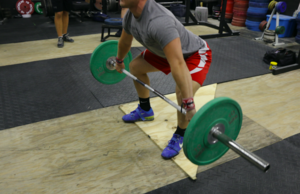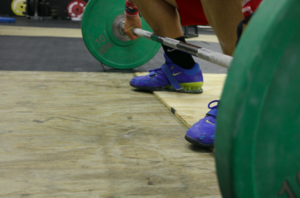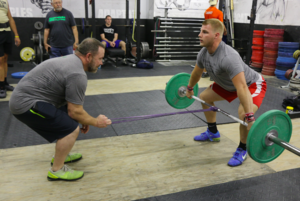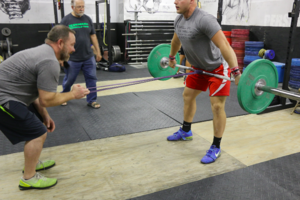I have been to hundreds of weightlifting meets at this point. Every year I go to local, national, and international meets. I get to see athletes from all over the United States and around the world. When I am watching a meet, I try to analyze each lift to better understand the sport. I like to point out why the athlete made the lift, or why they missed the lift. This is all part of being a good coach.
Most coaches have their own opinions about technique. Since several of us are producing athletes for Team USA, I have to assume at this point that there is more than one technique or way of teaching that works. Personal,ly I am not set in stone with any one technique. I simply want to find something that works for the athlete. Just like I want to make programming fit the athlete, I want to find a technique that fits the athlete. I don’t want the athlete trying to fit the technique.
When looking at technique, you have to take into consideration each athlete’s anthropometrics. This is simply a fancy word for the measurements of someone’s body, or even simpler the way that an athlete is built. Here are a few of our non-negotiables in reference to starting position:
• Shoulders must start and stay above the hips
• A tight neutral spine with no rounding
• Knees parallel with elbows or slightly in front
• Eyes straight ahead
• Long arms with elbows out
That’s really it. Coach McCauley probably has a few more, but I am not as set in stone as he is. During the initial pull or first pull, the hips might rise slightly faster than the shoulders, and that’s ok. However, the goal is to keep the chest up as much as possible. We basically talk about ‘showing our chest to the crowd’ during the first pull. The reason that this is so important is because that this helps prevent the most common mistake in weightlifting. I guess it’s time to reveal this treacherous mistake that steals the hopes and dreams of so many athletes.
The most common mistake is getting pulled onto your toes during the initial 4-6 inches of the pull. This mistake infuriates me because this is totally on the athlete. We are in control of those first few inches because the bar is just starting to move. It hasn’t picked up that extraordinary speed that it is about to demonstrate during the next stages of the pull.
So how does this terrible mistake happen? That’s a great question, and I am glad that you asked. Normally it’s due to the athlete rushing and trying to rip the weight off the floor. However, the job of the first pull is to set up the second and third pulls, which is where the real magic happens. If you get pulled forwards right off the floor, that’s a missed lift every time with circa-maximum weights.
[thrive_leads id=’10673′]
When you get pulled onto your toes, normally a couple of bad things happen:
- The Bar is pulled away from the body, and by that happening you just increased the spinal extensor demand, the hip extensor demand, and the knee extension demand. Moment is force applied about an axis, that is the force applied multiplied by the distance from the axis perpendicular to the direction the force is being applied. When the weight shifts forwards, it is now farther from all point of axis. Without going into a physics lesson, you should know that every millimeter counts not only for required force but also the position where the bar lands. If the bar drifts out in front even the slightest bit, it’s now hard to get the bar back in the right position.
- Harder to Sweep Back- we teach our athletes to sweep back with the latissimus dorsi, or technically put we want to ensure proper shoulder extension keeping the bar as close to the body as possible. If the bar drifts forwards, the angle created at the armpit by the torso and the humerus. Obviously, when the angle of the armpit gets wider, that in turn lengthens the lats (latissimus dorsi) making it harder to sweep the bar close.
Now that we know what the number one mistake is, the question becomes how do you fix it? We use a couple of things to fix it. Let’s look at a few of those ways.
Pauses During The Pull
I like to pause the pull anywhere from 2” off the floor all the way to the knee. Isometric Contractions are great for strengthening positions by strengthening the joints at the particular angle that you are pausing. Pauses also teach the nervous system where the bar should be during the pull. We normally pause anywhere from 2-5 seconds per repetition.
The McCauley Platform
If you are constantly getting pulled forwards onto your toes, Coach McCauley has the thing for you. He uses a piece of plywood to put your feet on while dangling your toes off the end. This platform helps the athlete learn how to pull with the weight focused on the ball of the foot without shifting forwards. I watched Coach McCauley take athletes from 10th place nationally to 1st place simply by using this platform.
Pulling Against Pins
You will need a power rack for this exercise. Once again you will be using isometric contractions to strengthen the muscles at the particular joint angle that the contraction is performed. You can set the pins at 2” or a few more, and then perform repetitions of 3-5 holding for 3-5 seconds. The keys are: 1. to make sure that you are at the proper position when performing the contractions and 2. Pull as hard as possible during the contraction.
Horizontal Bands
I love to use horizontal bands to teach athletes how to sweep back. You will need something to attach the bands in front of you, or you can get someone to hold the band. We get our athletes to perform Snatch or Clean Pulls slowly, while experiencing the horizontal pull of the bands. That horizontal force will cause you to contract your lats to keep the bar from being pulled forwards by the bands. This is the sweeping back that we talk about. It’s a great way of teaching the concept.
When an athlete is having trouble with a movement, you can give them external cues until you are blue in the face, and those cues won’t help at all until an athlete grasps the issue. Drills that teach the proper movement pattern along with the verbal cues is the best way to fix a dysfunctional movement pattern. I like to think about getting the most with saying the least. The Olympic lifts are simply too fast for verbal cues until the athlete grasps the proper movement pattern. Once you get the movement pattern down, then an external verbal cue does a great job to reinforce that movement.
Look guys, those first few inches are on you. By that I mean, you can control those first few inches with:
- Practice
- Focus
- Proper set up
If you will work on the start, you can eliminate or at least lessen the most common mistake in weightlifting. Remember it’s not about the speed of the start. It’s about the speed of the second and third pulls. The speed of those pulls is directly affected by the proper position of the initial few inches of the first pull. I am not necessarily saying to pull the bar slow off of the floor. I am saying to pull it as fast as possible under control. The speed will depend on your level of control off of the floor. Now go practice your movement!
[thrive_leads id=’8207′]





Love the horizontal band idea! Going to put that one into practice very soon. Thanks!!
Pingback: Stay Off Your Toes – by Vinh Huynh – Mash Elite Performance